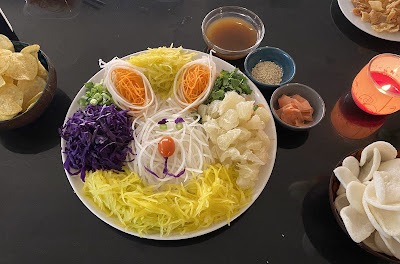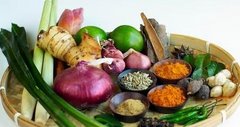Gong Xi Fa Chai!, Kiong Hee Huat Chai, Kong Hei Fatt Choy!, Selamat Tahun Baru China, Happy Chinese New Year, Xīnnián kuàilè, 新年快乐 !!!
Chinese New Year wouldn't be complete without a few key things; angpows, resplendent reunion dinner and of course, Yee Sang. Yee Sang is something that is uniquely Malaysian.
Yee Sang, dubbed YuSheng or Prosperity Toss, is a common ritual done on Chinese New Year to signify an auspicious start to the year. Yee Sang is a type of salad that is traditionally prepared with raw fish, carrots, white radish, pickled ginger, pomelo, peanuts, sesame seeds, crackers, five spice powder, pepper, oil and plum sauce. Every ingredient represents prosperous meanings: pomelo and carrot for luck, white radish for promotion at work and fish for abundance.
The dish is then assembled on a plate for the Prosperity Toss (lou hei) in which the vegetables are first beautifully laid on a plate, excluding peanuts, sesame seeds, crackers, powders, oil and sauce, which auspicious saying are uttered while the final ingredients are added. Then diners will toss the ingredients into the air with more auspicious wishes. This is why the dish's actual name is Lou Hei Yee Sang (捞起魚生)
Where Did Yee Sang Come From?
Although instinctively one would assume Yee Sang comes from China, its current iteration that we all know so well was actually birthed in Malaysia itself. Legend has it that the original Yee Sang was created by Loke Ching Fatt, originally a Cantonese immigrant from China, in the 1940s who owned a small catering business called Loke Ching Kee in the sleepy town of Seremban. As Malaya was going through recovery from World War II, Loke decided to pivot his business by creating the Lo Hei Yee Sang, a dish was inspired by the Chinese celebration of Ren Ri (人日), the 7thday of the Chinese New Year, where humanity was created according to myth. As it was common for the Cantonese to eat raw fish on that day, Loke decided to create the dish we know and love today, taking some inspiration from not only Cantonese culture, but Teochew and Hokkien cultures which were prevalent in Malaya as well. The dish was also prepared intentionally ritualistic, ensuring that the flavour and colours are observed for the auspicious new year. In the past, Grass Carp (waan jyu, 鯇魚) would be used, where they would be starved for a few days to ensure all impurities are gotten rid of before slicing up for the preparation, however, today salmon would be the most common form of preparation.





No comments:
Post a Comment